‘Woman Life Freedom,’ One Year Later
After hundreds killed and thousands jailed, the hijab is still mandatory in Iran.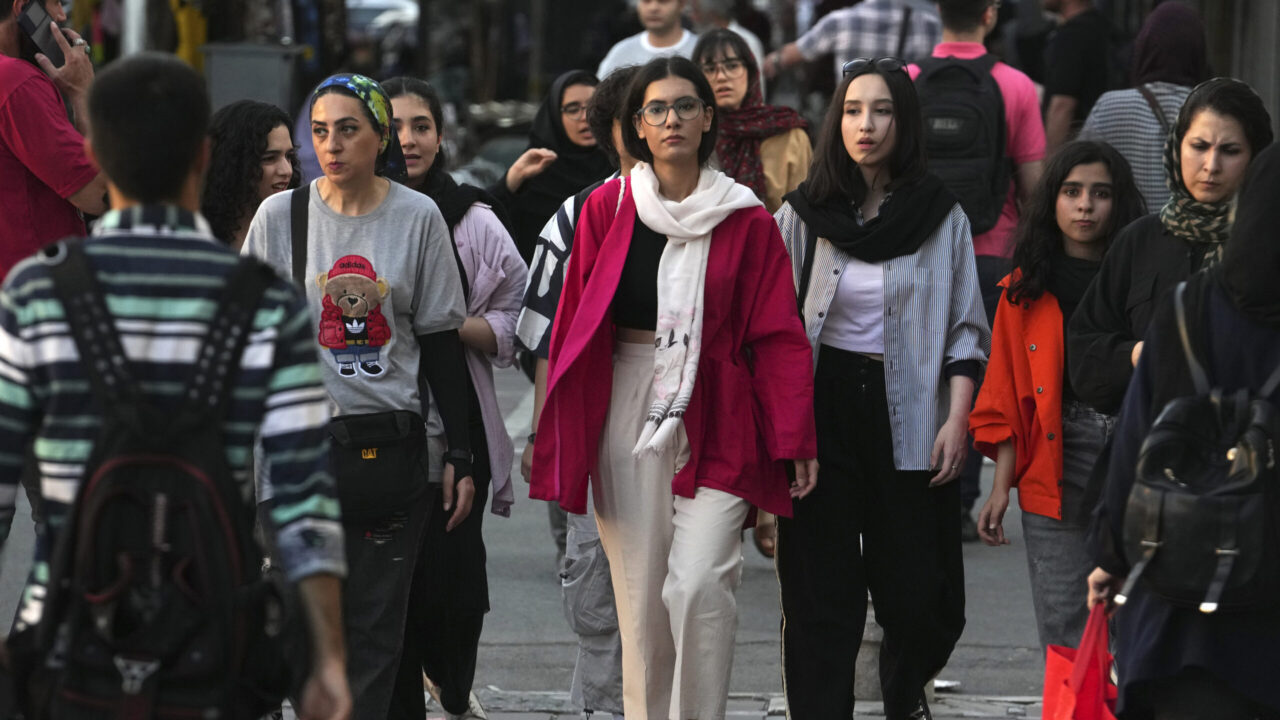 Iranian women, some without wearing their mandatory Islamic headscarves, walk in downtown Tehran, Iran, Saturday, Sept. 9, 2023. (AP Photo/Vahid Salemi)
Iranian women, some without wearing their mandatory Islamic headscarves, walk in downtown Tehran, Iran, Saturday, Sept. 9, 2023. (AP Photo/Vahid Salemi)
It has been a year since the women of Iran took to the streets to throw their headscarves into bonfires, while chanting, “Zan Zendegi Azadi” —“Woman Life Freedom.” Their fury was triggered by the killing of a young Kurdish-Iranian woman, Mahsa Jina Amini, who died in the custody of the Morality Police following her arrest for the crime of wearing a “bad hijab.” At Jina’s graveside in Kurdistan, family members had ripped off their headscarves and cut their hair, gestures of mourning and defiance that sparked wider protests in cities across the country that adopted the traditional cry of Kurdish liberation struggle as their own. The hashtag #mahsaamini and #womanlifefreedom went viral; famous actresses and the First Lady of the United States lauded the women of Iran for their bravery.
The regime met the protests with brute force, instructing its security apparatus to quell the demonstrations at any cost. Horrific video images soon emerged of ordinary people shot by rubber and live bullets. Hundreds of protestors have been killed, tens of thousands jailed and seven executed. (These are estimates, as the Islamic regime has not released official figures). A year later, Iran’s jails groan with an ever-increasing number of activists, musicians, rappers, artists, lawyers and environmentalists, many of them targeted and tracked through social media or delivery apps. Reports of systematic torture and rape have proliferated, as have stories of young protestors committing suicide after their release. The families of killed protestors are frequently arrested or harassed to keep them silent.
Glance at the images coming out of Iran today, and you might be forgiven for thinking headscarves are no longer part of the mandatory dress code in the Islamic Republic of Iran. Pictures proliferate of women going about their daily lives with their hair uncovered, shopping for food, going to restaurants, walking down the street. Many outside Iran assume that the protests have ended in victory, and that the regime has been forced to quietly tolerate this change.
A year later, Iran’s jails groan with an ever-increasing number of activists, musicians, rappers, artists, lawyers and environmentalists, many of them targeted and tracked through social media or delivery apps.
But while these photos depict brave acts of civil disobedience, they represent a tiny minority of women, most of them in the leafy northern reaches of Tehran inhabited by the richest families, including members of the regime and its cronies. As the protests have emboldened women in other parts of the country, including smaller cities and even some rural areas, the regime continues to take extreme measures to intimidate them back into a “correct” hijab.
Regime officials claim that the Morality Police have been taken off the streets of Iran, but these statements are designed for Western audiences. In reality, the Morality Police have been back on the streets since July, and the regime has further hardened and entrenched its position. The mandatory hijab is a cornerstone of the Islamic regime’s creed and loosening this requirement — even in the face of engulfing national protests — would be seen as an intolerable defeat and weakening of the revolutionary ideology that the notorious Revolutionary Guard (the IRGC) is sworn to protect. And it is the IRGC, not the regular police or even army forces, that have been in the streets brutally repressing the protests.
They are aided by an increasingly sophisticated national surveillance system that involves repurposed traffic control and metro station cameras, cutting-edge facial recognition technology and intensive monitoring of social media. In recent months, numerous reports have surfaced of businesses — including offices, shops, restaurants and cafes — forced to close following the identification of women not wearing headscarves on their premises. Major Iranian online marketplaces Digikala and Taghcheh, as well as Azki insurance, were forced to cease operations after photos appeared on social media of their female employees not wearing full hijab.
In June of this year, the commander-in-chief of the Islamic Republic of Iran’s Law Enforcement (effectively the chief of police), Ahmadreza Radan, confirmed the expanded use of CCTV cameras to identify women who reject the mandatory hijab. “The implementation of the strategy involving surveillance cameras to address noncompliance with hijab is currently underway,” he said. “Individuals who breach the hijab requirement are swiftly identified through this system. Initially, a first text message serves as a warning, after which subsequent messages involve coordination between judicial and police entities.”
Radan explained that four supervisors will oversee implementation of state policy, with one office tasked with identifying those who disobey hijab rules online and encourage others to do so. Between April and June of this year, according to official announcements, more than 1 million women received text messages warning their cars could be confiscated because they were spotted on camera not wearing headscarves. As detailed in a July report by Amnesty International, many women have also been barred from accessing universities, public transport and bank services.
Regime discussions about a surveillance program to monitor women’s dress — and their opinions on women’s dress — preceded the eruption of protest in September of 2022. “Should an individual choose not to adhere to hijab while in public spaces such as the subway, surveillance cameras installed within the subway will capture an image of the person, subsequently resulting in a significant fine,” Seyyed Mohammad Saleh Hashemi Golpayegani, the secretary of the Headquarters for the Promotion of Virtue and Prevention of Vice, a state-run body in charge of enforcing the mandatory hijab, stated in August of last year, weeks before the death of Mahsa Jina Amini.
Regime officials claim that the Morality Police have been taken off the streets of Iran, but these statements are designed for Western audiences.
In the legislative arena, meanwhile, a law called the Bill to Support the Family by Promoting the Culture of Chastity and Hijab was presented in parliament in May of this year. Although it is currently being debated in secret closed-door sessions, it has not escaped notice, in Iran or the wider world.
“The draft law could be described as a form of gender apartheid, as authorities appear to be governing through systemic discrimination with the intention of suppressing women and girls into total submission,” wrote a group of experts with the U.N. Commission on Human Rights earlier this month. “The bill also violates fundamental rights, including the right to take part in cultural life, the prohibition of gender discrimination, freedom of opinion and expression, the right to peaceful protest and the right to access social, educational, and health services, and freedom of movement.”
Indeed, the bill proposes a tiered system of punishments for noncompliant women, defined as women who display “nudity, lack of chastity, lack of hijab, bad dressing and acts against public decency leading to disturbance of peace.” Along with punitive fines and jail time, the law would empower public institutions to deny essential services to women charged with infractions. It also criminalizes nonenforcement by directors and managers of organizations.
After a year of “Woman Life Freedom” protest, and much sacrifice, the basic human rights of Iranian women are no closer to being achieved. But Iran’s protesters are still strong, as jailed and tortured human rights lawyer and activist Narges Mohammadi emphasized in a statement released on Instagram two days before the anniversary — and a few days after she herself was brutally beaten in front of other prisoners. “September 16th is the day marking the oppression of the religious authoritarian government against the women of Iran,” she wrote. “On this day… let us be the voice of revolutionary protest, and with every possible means, let us show our protest in every square and street. Our steadfastness, resistance, and courage are signs of our victory. The final victory is certain.
Dig deeper into the #WomanLifeFreedom protests….
Kamin Mohammadi’s Truthdig essay on the Kurdish women at the heart of the WomanLifeFreedom protests is part of “Woman Life Freedom: Voices and Art from the Women’s Protests in Iran,” a compilation of essays commemorating the one-year anniversary of the movement. The essay recently received an LA Press Club award.
Your support matters…Independent journalism is under threat and overshadowed by heavily funded mainstream media.
You can help level the playing field. Become a member.
Your tax-deductible contribution keeps us digging beneath the headlines to give you thought-provoking, investigative reporting and analysis that unearths what's really happening- without compromise.
Give today to support our courageous, independent journalists.
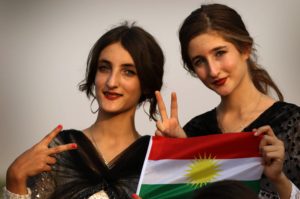
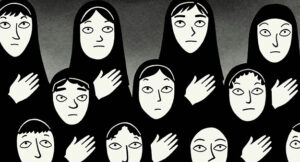
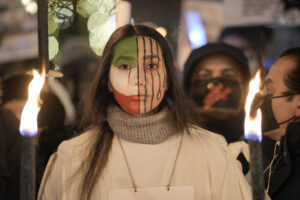
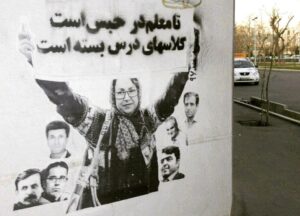


Thank you for this article which offers only some obvious information with no analysis. There is very little mention of the fact that the Western media and Governments have actually been supporting the Islamic Republic this past year, providing them with further funds (on the pretext of prisoner exchange), electing the terrorist regime to the Chair of the UNHRC and inviting the leaders to the US, giving them platform to speak.
The is...
Thank you for this article which offers only some obvious information with no analysis. There is very little mention of the fact that the Western media and Governments have actually been supporting the Islamic Republic this past year, providing them with further funds (on the pretext of prisoner exchange), electing the terrorist regime to the Chair of the UNHRC and inviting the leaders to the US, giving them platform to speak.
The is a blatant betrayal of the women and people killed and imprisoned in Iran. The fact that you have not mentioned any of these shows that you are also an agent of the mainstream media, all of whom have remained silent against the atrocities and complicity perpetrated against the Iranian people. A pity and a great shame that you can not be honest.
At this time of great hardship for the Iranian people who are losing their lives every single day to gain basic human rights and dignity we do not want yet another whitewasher but someone who can be courageous enough to speak the truth.